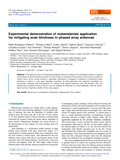Mostrar el registro sencillo del ítem
Experimental demonstration of metamaterials application for mitigating scan blindness in phased array antennas
| dc.creator | Rodríguez Ulibarri, Pablo | es_ES |
| dc.creator | Crépin, Thomas | es_ES |
| dc.creator | Martel, Cédric | es_ES |
| dc.creator | Boust, Fabrice | es_ES |
| dc.creator | Falcone Lanas, Francisco Javier | es_ES |
| dc.creator | Loecker, Claudius | es_ES |
| dc.creator | Herbertz, Kai | es_ES |
| dc.creator | Bertuch, Thomas | es_ES |
| dc.creator | Dousset, Thierry | es_ES |
| dc.creator | Martinaud, Jean-Paul | es_ES |
| dc.creator | Maci, Stefano | es_ES |
| dc.creator | Marcotegui, José Antonio | es_ES |
| dc.creator | Beruete Díaz, Miguel | es_ES |
| dc.date.accessioned | 2016-10-06T16:16:51Z | |
| dc.date.available | 2016-10-06T16:16:51Z | |
| dc.date.issued | 2016 | |
| dc.identifier.issn | 2272-2394 (Electronic) | |
| dc.identifier.uri | https://hdl.handle.net/2454/22365 | |
| dc.description.abstract | This paper presents two metamaterial-inspired solutions to mitigate the scan blindness effects in a phased array antenna. In the first solution, portions of a bed of nails are introduced in the radome to prevent the excitation of surface waves. In the second solution, a superstrate metasurface is designed to synthesize a permittivity tensor optimized to achieve a wide angle impedance matching. In both approaches, the numerical simulations are successfully compared with measurements of a phased array antenna prototype with 100 elements. The wire medium-based solution reveals an effective way for reducing the blind-spot in a wide bandwidth, while the metaradome has been found less suitable for the same purpose. | es_ES |
| dc.description.sponsorship | This work was supported by the METALESA project A-1089- RT-GC that was coordinated by the European Defence Agency (EDA) and funded by 11 contributing Members (Cyprus, France, Germany, Greece, Hungary, Italy, Norway, Poland, Slovakia, Slovenia and Spain) in the framework of the Joint Investment Programme on Innovative Concepts and Emerging Technologies (JIP-ICET). | en |
| dc.format.mimetype | application/pdf | en |
| dc.language.iso | eng | en |
| dc.publisher | EDP Sciences | en |
| dc.relation.ispartof | EPJ Applied Metamaterials, 2016, 3, 9 | en |
| dc.rights | © P. Rodríguez-Ulibarri et al. This is an Open Access article distributed under the terms of the Creative Commons Attribution License, which permits unrestricted use, distribution, and reproduction in any medium, provided the original work is properly cited. | en |
| dc.rights.uri | http://creativecommons.org/licenses/by/4.0/ | |
| dc.subject | Phased array | en |
| dc.subject | Scan blindness | en |
| dc.subject | Metasurfaces | en |
| dc.subject | Metamaterials | en |
| dc.subject | Wire medium | en |
| dc.title | Experimental demonstration of metamaterials application for mitigating scan blindness in phased array antennas | en |
| dc.type | Artículo / Artikulua | es |
| dc.type | info:eu-repo/semantics/article | en |
| dc.contributor.department | Ingeniería Eléctrica y Electrónica | es_ES |
| dc.contributor.department | Ingeniaritza Elektrikoa eta Elektronikoa | eu |
| dc.rights.accessRights | Acceso abierto / Sarbide irekia | es |
| dc.rights.accessRights | info:eu-repo/semantics/openAccess | en |
| dc.identifier.doi | 10.1051/epjam/2016010 | |
| dc.relation.publisherversion | https://dx.doi.org/10.1051/epjam/2016010 | |
| dc.type.version | Versión publicada / Argitaratu den bertsioa | es |
| dc.type.version | info:eu-repo/semantics/publishedVersion | en |



